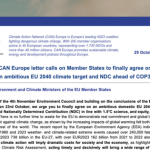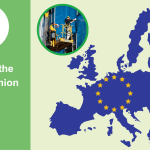- Emissions Trading System’s agreement raises climate ambition, but is still not in line with the 1.5°C goal and the 70% emissions reduction needed
- Free pollution permits to industry will only be phased out fully by 2034, leaving big polluters continue to receive billions of allowances without paying for their emissions
- On a positive side, lawmakers agreed to earmark ETS revenue, making it compulsory for Member States to dedicate all their auctioning revenues to climate action investments
Brussels, 18 December 2022 – The EU missed a critical chance to significantly ramp up its climate ambition in one of its key enablers: the EU carbon market. EU negotiators clinched a disappointing deal on the revision of the ETS – Emissions Trading System, this night. The deal fails to deliver on the EU’s fair share to the 1.5 Paris Agreement target and heavily favours the protection of the polluting industry over the people.
Negotiators did not truly go beyond the level of ambition proposed by the European Commission and settled on 62% emission cuts for the ETS sectors by 2030, clearly missing a vital chance to strengthen the EU carbon market and boosting the EU’s 2030 emission reduction target. This is far below the 70% emission cuts needed under ETS to deliver on the EU’s fair share contribution to efforts limiting global warming to 1.5°C as foreseen under the Paris Agreement. With its massive historic responsibility for the current climate emergency and its capacity to act as a strong industrialised economy, the European Union needs to do more than the global average to reduce emissions.
“Only weeks after COP27 rang the alarm bells that the 1.5°C target is on life support, EU lawmakers missed an important and obvious opportunity to get the EU on track. What they agreed last night fails to put the ETS in line with the Paris Agreement objective and hence does not represent a fair contribution to fighting dangerous climate change”, said Klaus Röhrig, Head of Climate in CAN Europe.
Also in the context of the ongoing Russian war against Ukraine, much stronger climate policy, in combination with solid support for vulnerable households, is essential for Europe to wean itself off of fossil fuels which lie at the heart of the current price crisis and the climate emergency. Yet, the EU legislators decided today to continue feeding under-performing industry with free pollution permits instead of steering the wheel in a fairer direction and ensure support for the transition of low-income households towards energy efficiency and 100% renewables.
“Lawmakers clearly put protection of industry over that of people and planet. Big polluters go home with pockets full of free money while people in comparison receive breadcrumbs to go through yet another fossil winter”, added Klaus Röhrig.
On a positive note, negotiators tightened the rules under which EU governments need to spend the immense amount of revenue generated by the auctioning of ETS allowances, making it obligatory for Member States to funnel 100% of their auctioning income to climate action.
A heavy blow however was dealt to the Modernisation Fund, which is to provide around EUR 55 billion to lower income Member States to modernise their energy systems at home. The Council pushed strongly for opening even more doors to fossil gas-based investments within the Fund. The European Parliament gave in, sending green light to beneficiary Member States for wasting at least EUR 4.8 billion of EU money for investments into fossil gas energy production, and much more on gas-based cogeneration thereby risking gas-lock-in and stranded assets, instead of steering every single cent for future-proof solutions: energy efficiency, modernisation of energy networks and 100% renewables.
Quotes from other NGOs
Agnese Ruggiero, Lead on EU carbon market and industrial decarbonisation at Carbon Market Watch: “Massive freebies to heavy industry have once again prevailed and will slow down emission reductions by large polluting sectors in the coming decade. Yet again, this taints the credibility of the ETS. It is a slap in the face of EU citizens who are expected to pay for the carbon emissions in the building and transport sectors, while their governments continue to hand out hundreds of billions in free pollution subsidies to industry”.
Camille Maury, Senior Policy Officer, Decarbonisation of Industry at WWF European Policy Office, said: “It’s welcomed that co-legislators agreed on phasing-in CBAM as of 2026 and phasing out almost half of free permits to pollute for CBAM sectors by 2030. However, the pace of reduction of free allowances over the years is too slow, and the full-phase out will only happen in 2034. Industry will continue to receive billions in freebies in the next decade. It’s like upholding the ‘polluter-pays-principle’ in principle but not fully. Meanwhile, society will pay the costs of the transition.”
Romain Laugier, Climate & Energy Policy Officer at WWF European Policy Officer, said: “EU countries will now have to spend all their ETS cash on climate action, and this is definitely a step forward. Unfortunately, the quality of a ‘climate action spending’ is still entirely up to Member States. It means they could continue as before, and use some of this money to subsidise fossil coal and gas”.
Chiara Corradi, climate policy officer at T&E, says: “With the Social Climate Fund the EU has addressed the social and climate crisis with a single instrument for the very first time. The ETS2 will be key to reaching our climate goals. It is good to have safeguards such as a price ceiling in the new carbon market, however it is regrettable that Big Oil won’t contribute by paying part of the carbon price as the European Parliament demanded”.
“Meanwhile, a two-speed allocation of free emission permits for primary and secondary steel and aluminium will be the death knell for circularity in Europe. This is a sad day for circularity as the EU runs after wind mills, blindly throwing money into the hydrogen drain”, stated Sandbag’s Director, Adrien Assous.
BACKGROUND
The informal agreement reached last night in trilogue still needs to be officially approved before entering into force, usually a mere formality. After the Carbon Border Adjustment Mechanism (CBAM) was approved earlier this week, and the recent agreements on the Effort Sharing Regulation (ESR) and on Land Use (LULUCF), the conclusion of the ETS marks the end of the negotiation of the climate part of the ‘Fit For 55’ package. Major energy-related parts of the package, however, still need to be finalised in the new year.
The Emissions Trading System legislative file is a key part of the EU’s ‘Fit for 55’ package that targets to cut net greenhouse gases (GHG) emissions by 55% by 2030 and an important milestone of the European Green Deal objective to make the bloc climate neutral by 2050.
Science shows us that it is possible for the EU to achieve at least 65% emission cuts by 2030 and climate neutrality by 2040, which is in line with the Paris Agreement goal.
Notes for editors
-
- CAN Europe position paper on Emissions Trading System
- CAN Europe position paper on Climate Policy Architecture
- CAN Europe reaction to ESR agreement
- CAN Europe position paper on Effort Sharing
- CAN Europe reaction to LULUCF agreement
- CAN Europe position paper on LULUCF
Contact: Cristina Dascalu, senior communication coordinator, cristina.dascalu@caneurope.org, communications@caneurope.org



